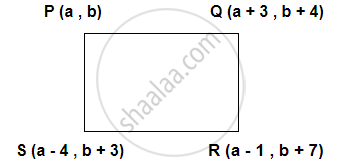Advertisements
Advertisements
Question
Prove that the points (a, b), (a + 3, b + 4), (a − 1, b + 7) and (a − 4, b + 3) are the vertices of a parallelogram.
Solution

PQ = `sqrt (("a" + 3 - "a")^2 + ("b" + 4 - "b")^2) = sqrt (9 + 16) = 5` units
QR = `sqrt (("a" + 3 - "a" + 1)^2 + ("b" - 4 - "b" - 7)^2) = sqrt (16 + 9) = 5` units
RS = `sqrt (("a" -1 - "a" + 4)^2 + ("b" + 7 - "b" - 3)^2) = sqrt (9 + 16) = 5` units
SP = `sqrt (("a" - 4 - "a")^2 + ("b" + 3 - "b")^2) = sqrt (16 + 9) = 5` units
Since the opposite sides of quadrilateral PQRS are equal, therefore it is a parallelogram.
APPEARS IN
RELATED QUESTIONS
If A and B are the points (−6, 7) and (−1, −5) respectively, then the distance
2AB is equal to
P(5 , -8) , Q (2 , -9) and R(2 , 1) are the vertices of a triangle. Find tyhe circumcentre and the circumradius of the triangle.
What point on the x-axis is equidistant from the points (7, 6) and (-3, 4)?
Prove that the points P (0, -4), Q (6, 2), R (3, 5) and S (-3, -1) are the vertices of a rectangle PQRS.
Calculate the distance between the points P (2, 2) and Q (5, 4) correct to three significant figures.
If the point (x, y) is at equidistant from the point (a + b, b – a) and (a-b, a + b). Prove that ay = bx.
The equation of the perpendicular bisector of line segment joining points A(4,5) and B(-2,3) is ______.
The distance between the points A(0, 6) and B(0, –2) is ______.
A circle has its centre at the origin and a point P(5, 0) lies on it. The point Q(6, 8) lies outside the circle.
Show that Alia's house, Shagun's house and library for an isosceles right triangle.
